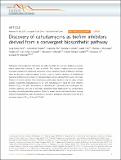Mostrar el registro sencillo del ítem
Discovery of cahuitamycins as biofilm inhibitors derived from a convergent biosynthetic pathway
| dc.creator | Park, Sung Ryeol | |
| dc.creator | Tripathi, Ashootosh | |
| dc.creator | Wu, Jianfeng | |
| dc.creator | Schultz, Pamela J. | |
| dc.creator | Yim, Isaiah | |
| dc.creator | McQuade, Thomas J. | |
| dc.creator | Yu, Fengan | |
| dc.creator | Arevang, Carl Johan | |
| dc.creator | Mensah, Abraham Y. | |
| dc.creator | Tamayo Castillo, Giselle | |
| dc.creator | Xi, Chuanwu | |
| dc.creator | Sherman, David H. | |
| dc.date.accessioned | 2018-04-05T20:20:47Z | |
| dc.date.available | 2018-04-05T20:20:47Z | |
| dc.date.issued | 2016-02-16 | |
| dc.identifier.citation | https://www.nature.com/articles/ncomms10710 | |
| dc.identifier.issn | 2041-1723 | |
| dc.identifier.other | Article number: 10710 (2016) | |
| dc.identifier.uri | https://hdl.handle.net/10669/74422 | |
| dc.description.abstract | Pathogenic microorganisms often have the ability to attach to a surface, building a complex matrix where they colonize to form a biofilm. This cellular superstructure can display increased resistance to antibiotics and cause serious, persistent health problems in humans. Here we describe a high-throughput in vitro screen to identify inhibitors of Acinetobacter baumannii biofilms using a library of natural product extracts derived from marine microbes. Analysis of extracts derived from Streptomyces gandocaensis results in the discovery of three peptidic metabolites (cahuitamycins A–C), with cahuitamycin C being the most effective inhibitor (IC50=14.5 μM). Biosynthesis of cahuitamycin C proceeds via a convergent biosynthetic pathway, with one of the steps apparently being catalysed by an unlinked gene encoding a 6-methylsalicylate synthase. Efforts to assess starter unit diversification through selective mutasynthesis lead to production of unnatural analogues cahuitamycins D and E of increased potency (IC50=8.4 and 10.5 μM). | es_ES |
| dc.description.sponsorship | Great Lakes Regional Center of Excellence for Biodefense and Emerging Infectious Diseases/[U54 AI57153]/GLRCE/Estados Unidos | es_ES |
| dc.description.sponsorship | Army Research Office/[W911NF-12-1-0059]/ARO/Estados Unidos | es_ES |
| dc.description.sponsorship | National Institutes of Health/[1R01GM098350]/NIH/Estados Unidos | es_ES |
| dc.description.sponsorship | International Cooperative Biodiversity Groups-Fogarty International Center/[U01 TW007404]/ICBG/Estados Unidos | es_ES |
| dc.language.iso | en_US | es_ES |
| dc.rights | Atribución 4.0 Internacional | * |
| dc.rights.uri | http://creativecommons.org/licenses/by/4.0/ | * |
| dc.source | Nature Communications, Vol. 7, 10710, 2016 | es_ES |
| dc.subject | Biofilms | es_ES |
| dc.subject | Biosynthesis | es_ES |
| dc.subject | Natural products | es_ES |
| dc.subject | Peptides | es_ES |
| dc.title | Discovery of cahuitamycins as biofilm inhibitors derived from a convergent biosynthetic pathway | es_ES |
| dc.type | artículo original | |
| dc.identifier.doi | 10.1038/ncomms10710 | |
| dc.description.procedence | UCR::Vicerrectoría de Investigación::Unidades de Investigación::Ciencias Básicas::Centro de Investigaciones en Productos Naturales (CIPRONA) | es_ES |
Ficheros en el ítem
Este ítem aparece en la(s) siguiente(s) colección(ones)
-
Biología [1644]



